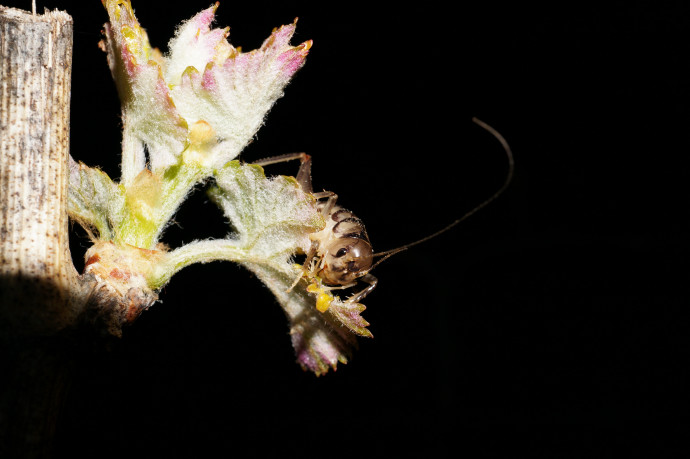Research
Published 9 September 2020Where wine wētā wander

A new paper in the New Zealand Journal of Zoology features research on the identification of the wine wētā, an examination of its ecology in vineyards, and a description of four new species.
In the paper ‘Ecology and systematics of the wine wētā and allied species, with description of four new Hemiandrus species’ published in the New Zealand Journal of Zoology researchers have been using mtDNA analysis and physicality to distinguish six wētā species within the Hemiandrus clade, a classification of ground-wētā where the adult females have a very short tube (ovipositor) for laying eggs.
Ground wētā spend the day in soil burrows and are not frequently encountered. Yet a type of ground wētā, dubbed the wine wētā, has been found in high density in some vineyards in the Awatere Valley in the northeast of the South Island. They are one of the few examples of an endemic species being positively influenced by humans in the area. The healthy wētā populations under the vines may be attributed to the irrigation practices used by vintiers during the drier times in the year. The estimated density of wine wētā in an Awatere vineyard is 3.4 wētā per square metre.
Wine wētā feed on the new opening buds of grapevines during springtime; however, this can damage the yield of the grapes. A current method of wētā control in vineyards is the placement of plastic sleeves over the grapevine trunks, with the intention of making the vine too slippery for the wētā to climb up. However, many wētā are still observed eating buds or feeding on sap despite the plastic sleeves.
The six species that are in the wine wētā clade share physical and behavioural traits linked to the maternal care of their young, with four new species named after sisters of the Pleiades. Before the wētā were found in the Awatere Valley, they were previously thought to inhabit only the lower end of the North Island. This recently uncovered geographic distribution likely represents a dispersal period occurring during the Pleistocene glacial phases, sometime between 2 million and 10,000 years ago, when sea levels were lower.
Further knowledge of the wine wētā would be useful to learn about its role as a predator within the grapevines, and the evolution, ecology and resilience of an endemic species in a rapidly changing world.
The journal article paper ‘Ecology and systematics of the wine wētā and allied species, with description of four new Hemiandrus species’ published in the New Zealand Journal of Zoology is by researchers Steven Trewick (Massey University), Briar Taylor-Smith (Tonkin + Taylor) and Mary Morgan-Richards (Massey University). The article is available to read in full at Taylor and Francis Online.
Authors Steven Trewick and Mary Morgan-Richards have written the book Wildlife New Zealand which focuses on the unique plants and animals of Aotearoa.
Steven A. Trewick, Briar Taylor-Smith & Mary Morgan-Richards (2020) Ecology and systematics of the wine wētā and allied species, with description of four new Hemiandrus species, New Zealand Journal of Zoology, DOI: 10.1080/03014223.2020.1790396
RESEARCHER
Professor Steven Trewick
ORGANISATION
Massey Univeristy
